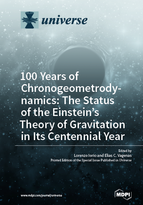100 Years of Chronogeometrodynamics: the Status of the Einstein's Theory of Gravitation in Its Centennial Year
A special issue of Universe (ISSN 2218-1997).
Deadline for manuscript submissions: closed (31 December 2016) | Viewed by 164440
Special Issue Editors
Interests: theoretical cosmology; cosmological constant problem; baryogenesis; cosmic inflation; structure formation; singularity resolution; quantum fields in curved spaces; string cosmology; quantum gravity; string theory; modified theories of gravity; loop quantum gravity; spin foams; geometry and math of music; instrument acoustic modelling
Special Issues, Collections and Topics in MDPI journals
Interests: cosmological physics; numerical cosmology; large scale structure formation; scalar-tensor and modified gravity theory; backreaction and inhomogeneous universes
Special Issues, Collections and Topics in MDPI journals
Interests: general relativity and gravitation; black hole physics; quantum gravity; quantum gravity phenomenology
Interests: general relativity and gravitation; classical general relativity; post-newtonian approximation, perturbation theory, related approximations; gravitational waves; observational cosmology; mathematical and relativistic aspects of cosmology; modified theories of gravity; higher-dimensional gravity and other theories of gravity; experimental studies of gravity; experimental tests of gravitational theories; geodesy and gravity; harmonics of the gravity potential field; geopotential theory and determination; satellite orbits; orbit determination and improvement; astrometry and reference systems; ephemerides, almanacs, and calendars; lunar, planetary, and deep-space probes
Special Issues, Collections and Topics in MDPI journals
Special Issue Information
Dear Colleagues,
In 1692, Newton wrote: "That gravity should be innate inherent and essential to matter so that one body may act upon another at a distance through a vacuum without the mediation of anything else by and through which their action or force may be conveyed from one to another is to me so great an absurdity that I believe no man who has in philosophical matters any competent faculty of thinking can ever fall into it. Gravity must be caused by an agent acting constantly according to certain laws, but whether this agent be material or immaterial is a question I have left to the consideration of my readers". One of them who, just over 200 years later, picked up the baton of Newton was Albert Einstein. His General Theory of Relativity, which marks the centenary this year, opened up new windows on our comprehension of Nature, disclosed new, previously unpredictable, phenomena occurring when relative velocities dramatically change in intense gravitational fields reaching values close to the speed of light and, for the first time after millennia of speculations, put Cosmology on the firm grounds of empirically testable science. This Special Issue is dedicated to such a grandest achievement of the human thought.
Prof. Lorenzo Iorio
Prof. Stephon Alexander
Prof. Jean-Michel Alimi
Prof. Elias C. Vagenas
Guest Editors
Manuscript Submission Information
Manuscripts should be submitted online at www.mdpi.com by registering and logging in to this website. Once you are registered, click here to go to the submission form. Manuscripts can be submitted until the deadline. All submissions that pass pre-check are peer-reviewed. Accepted papers will be published continuously in the journal (as soon as accepted) and will be listed together on the special issue website. Research articles, review articles as well as short communications are invited. For planned papers, a title and short abstract (about 100 words) can be sent to the Editorial Office for announcement on this website.
Submitted manuscripts should not have been published previously, nor be under consideration for publication elsewhere (except conference proceedings papers). All manuscripts are thoroughly refereed through a single-blind peer-review process. A guide for authors and other relevant information for submission of manuscripts is available on the Instructions for Authors page. Universe is an international peer-reviewed open access monthly journal published by MDPI.
Please visit the Instructions for Authors page before submitting a manuscript. Submitted papers should be well formatted and use good English. Authors may use MDPI's English editing service prior to publication or during author revisions.









